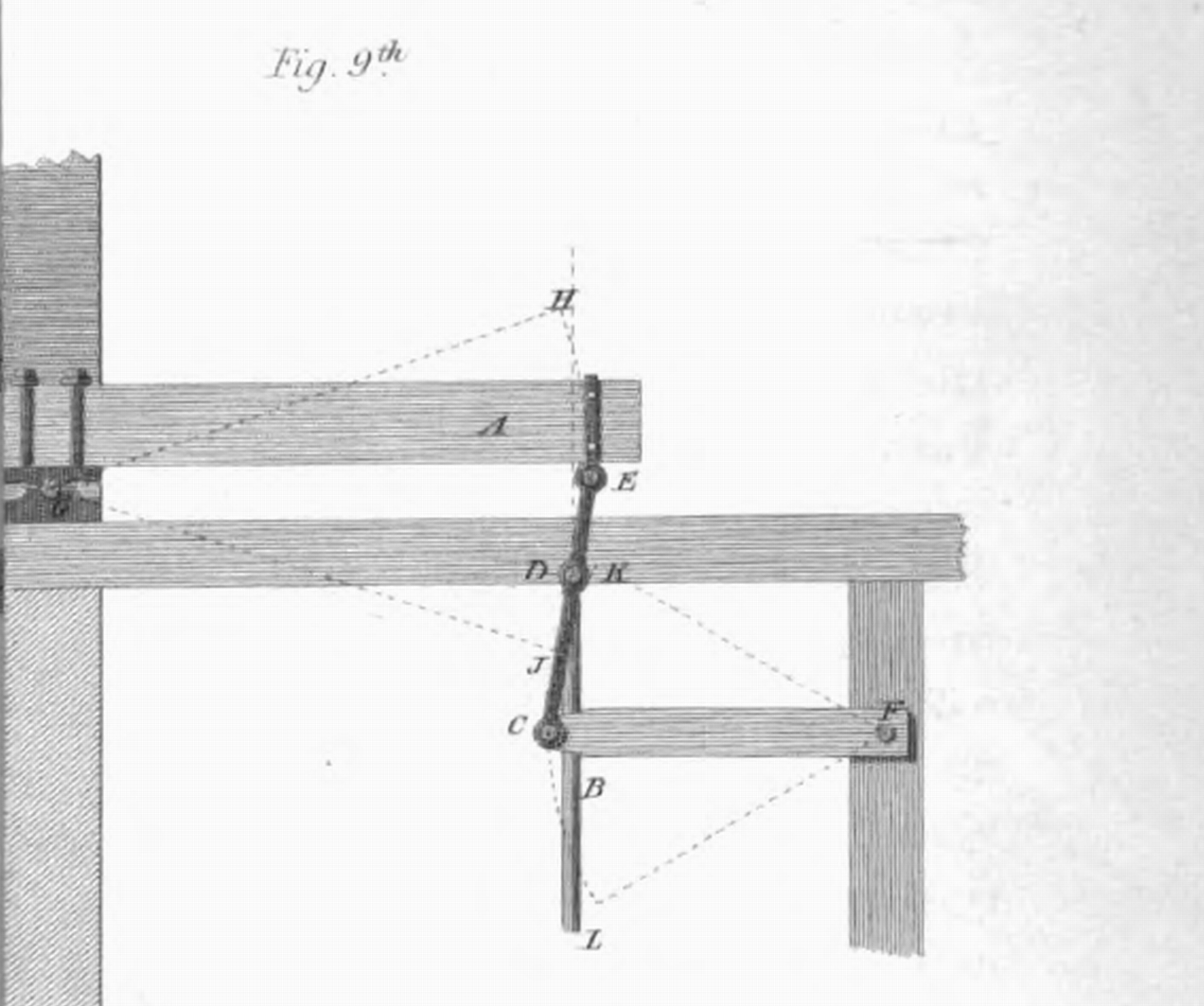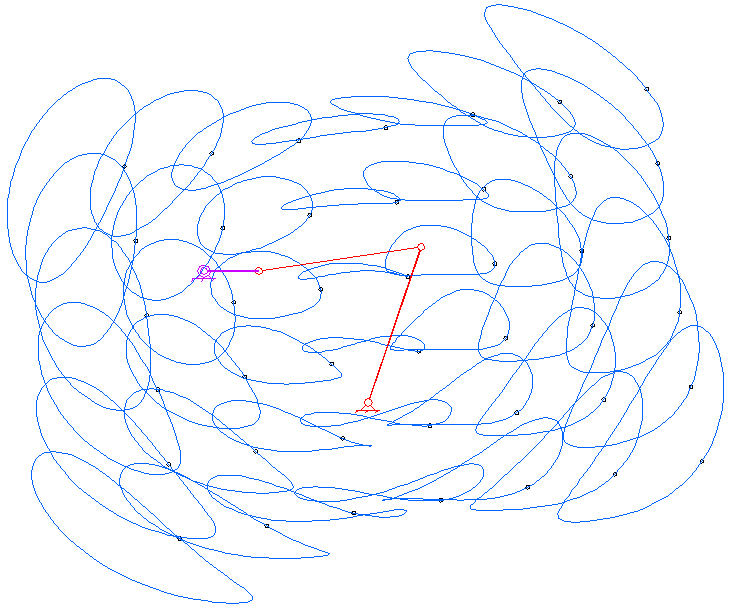|
Roberts Linkage
A Roberts linkage is a four-bar linkage which converts a rotational motion to approximate straight line mechanism, straight-line motion. The linkage was developed by Richard Roberts (engineer), Richard Roberts. The Roberts linkage can be classified as: * Watt's linkage, Watt-type linkage * Grashof condition, Grashof rocker-rocker * Symmetrical four-bar linkage References See also *Straight line mechanism *Four-bar linkage {{Mech-engineering-stub Linkages (mechanical) Straight line mechanisms ... [...More Info...] [...Related Items...] OR: [Wikipedia] [Google] [Baidu] |
Roberts Linkage
A Roberts linkage is a four-bar linkage which converts a rotational motion to approximate straight line mechanism, straight-line motion. The linkage was developed by Richard Roberts (engineer), Richard Roberts. The Roberts linkage can be classified as: * Watt's linkage, Watt-type linkage * Grashof condition, Grashof rocker-rocker * Symmetrical four-bar linkage References See also *Straight line mechanism *Four-bar linkage {{Mech-engineering-stub Linkages (mechanical) Straight line mechanisms ... [...More Info...] [...Related Items...] OR: [Wikipedia] [Google] [Baidu] |
Four-bar Linkage
In the study of mechanisms, a four-bar linkage, also called a four-bar, is the simplest closed- chain movable linkage. It consists of four bodies, called ''bars'' or ''links'', connected in a loop by four joints. Generally, the joints are configured so the links move in parallel planes, and the assembly is called a ''planar four-bar linkage''. Spherical and spatial four-bar linkages also exist and are used in practice. Planar four-bar linkage Planar four-bar linkages are constructed from four links connected in a loop by four one- degree-of-freedom joints. A joint may be either a revolute joint – also known as a pin joint or hinged joint – denoted by R, or a prismatic joint – also known as a sliding pair – denoted by P. A link that are fixed in place relative to the viewer is called a ''ground link.'' A link connecting to the ground by a revolute joint that can perform a complete revolution is called a '' crank link.'' A link connecting to the ground by a revolute join ... [...More Info...] [...Related Items...] OR: [Wikipedia] [Google] [Baidu] |
Straight Line Mechanism
A straight-line mechanism is a Mechanism (engineering), mechanism that converts any type of rotary or angular motion to perfect or near-perfect straight-line motion, or ''vice-versa''. Straight-line motion is linear motion of definite length or "stroke", every forward stroke being followed by a return stroke, giving reciprocating motion. The first such mechanism, patented in 1784 by James Watt, produced approximate straight-line motion, referred to by Watt as Watt's linkage, parallel motion. Straight-line mechanisms are used in a variety of applications, such as engines, vehicle suspensions, walking robots, and rover wheels. History In the late eighteenth century, before the development of the Planer (metalworking), planer and the milling machine, it was extremely difficult to machine straight, flat surfaces. During that era, much thought was given to the problem of attaining a straight-line motion, as this would allow the flat surfaces to be machined. To find a solution ... [...More Info...] [...Related Items...] OR: [Wikipedia] [Google] [Baidu] |
Richard Roberts (engineer)
Richard Roberts (22 April 1789 – 11 March 1864) was a Welsh patternmaker and engineer whose development of high-precision machine tools contributed to the birth of production engineering and mass production. Early life Roberts was born at Llanymynech, Powys, on the border between England and Wales. He was the son of William Roberts, a shoemaker, who also kept the New Bridge tollgate. Roberts was educated by the parish priest, and early found employment with a boatman on the Ellesmere Canal and later at the local limestone quarries. He received some instruction in drawing from Robert Bough, a road surveyor, who was working under Thomas Telford. Roberts then found employment as a patternmaker at Bradley Iron works, Staffordshire, and, probably in 1813, moved to a supervisory position in the pattern shop of the Horsely Iron works, Tipton. He had gained skills in turning, wheel-wrighting and the repair of mill-work. He was drawn for the militia and to avoid this made for Liv ... [...More Info...] [...Related Items...] OR: [Wikipedia] [Google] [Baidu] |
Watt's Linkage
In kinematics, Watt's linkage (also known as the parallel linkage) is a type of mechanical linkage invented by James Watt in which the central moving point of the linkage is constrained to travel on a nearly straight line. It was described in Watt's patent specification of 1784 for the Watt steam engine. Today it is used in automobile suspensions, allowing the axle of a vehicle to travel vertically while preventing sideways motion. Description Watt's linkage consists of three bars bolted together in a chain. The chain of bars consists of two end bars and a middle bar. The middle bar is bolted at each of its ends to one of the ends of each outer bar. The two outer bars are of equal length, and are longer than the middle bar. The three bars can pivot around the two bolts. The outer endpoints of the long bars are fixed in place relative to each other, but otherwise the three bars are free to pivot around the two joints where they meet. In linkage analysis there is an imaginary ... [...More Info...] [...Related Items...] OR: [Wikipedia] [Google] [Baidu] |
Grashof Condition
In the study of mechanisms, a four-bar linkage, also called a four-bar, is the simplest closed-chain movable linkage. It consists of four bodies, called ''bars'' or ''links'', connected in a loop by four joints. Generally, the joints are configured so the links move in parallel planes, and the assembly is called a ''planar four-bar linkage''. Spherical and spatial four-bar linkages also exist and are used in practice. Planar four-bar linkage Planar four-bar linkages are constructed from four links connected in a loop by four one- degree-of-freedom joints. A joint may be either a revolute joint – also known as a pin joint or hinged joint – denoted by R, or a prismatic joint – also known as a sliding pair – denoted by P. A link that are fixed in place relative to the viewer is called a ''ground link.'' A link connecting to the ground by a revolute joint that can perform a complete revolution is called a '' crank link.'' A link connecting to the ground by a revolute joint ... [...More Info...] [...Related Items...] OR: [Wikipedia] [Google] [Baidu] |
Straight Line Mechanism
A straight-line mechanism is a Mechanism (engineering), mechanism that converts any type of rotary or angular motion to perfect or near-perfect straight-line motion, or ''vice-versa''. Straight-line motion is linear motion of definite length or "stroke", every forward stroke being followed by a return stroke, giving reciprocating motion. The first such mechanism, patented in 1784 by James Watt, produced approximate straight-line motion, referred to by Watt as Watt's linkage, parallel motion. Straight-line mechanisms are used in a variety of applications, such as engines, vehicle suspensions, walking robots, and rover wheels. History In the late eighteenth century, before the development of the Planer (metalworking), planer and the milling machine, it was extremely difficult to machine straight, flat surfaces. During that era, much thought was given to the problem of attaining a straight-line motion, as this would allow the flat surfaces to be machined. To find a solution ... [...More Info...] [...Related Items...] OR: [Wikipedia] [Google] [Baidu] |
Four-bar Linkage
In the study of mechanisms, a four-bar linkage, also called a four-bar, is the simplest closed- chain movable linkage. It consists of four bodies, called ''bars'' or ''links'', connected in a loop by four joints. Generally, the joints are configured so the links move in parallel planes, and the assembly is called a ''planar four-bar linkage''. Spherical and spatial four-bar linkages also exist and are used in practice. Planar four-bar linkage Planar four-bar linkages are constructed from four links connected in a loop by four one- degree-of-freedom joints. A joint may be either a revolute joint – also known as a pin joint or hinged joint – denoted by R, or a prismatic joint – also known as a sliding pair – denoted by P. A link that are fixed in place relative to the viewer is called a ''ground link.'' A link connecting to the ground by a revolute joint that can perform a complete revolution is called a '' crank link.'' A link connecting to the ground by a revolute join ... [...More Info...] [...Related Items...] OR: [Wikipedia] [Google] [Baidu] |
Linkages (mechanical)
Linkage may refer to: * ''Linkage'' (album), by J-pop singer Mami Kawada, released in 2010 * Linkage (graph theory), the maximum min-degree of any of its subgraphs * Linkage (horse), an American Thoroughbred racehorse * Linkage (hierarchical clustering), The linkage criterion determines the distance between sets of observations as a function of the pairwise distances between observations * Linkage (linguistics), a set of languages descended from a former dialect continuum *Linkage (mechanical), assemblies of links designed to manage forces and movement *Linkage (policy), a Cold War policy of the United States of America towards the Soviet Union and Communist China *Linkage (software), a concept in computer programming * Genetic linkage, the tendency of certain genes to be inherited together *Glycosidic linkage, a type of covalent bond that joins a carbohydrate (sugar) molecule to another chemical group *Flux linkage In circuit theory, flux linkage is a property of a two-terminal ... [...More Info...] [...Related Items...] OR: [Wikipedia] [Google] [Baidu] |




